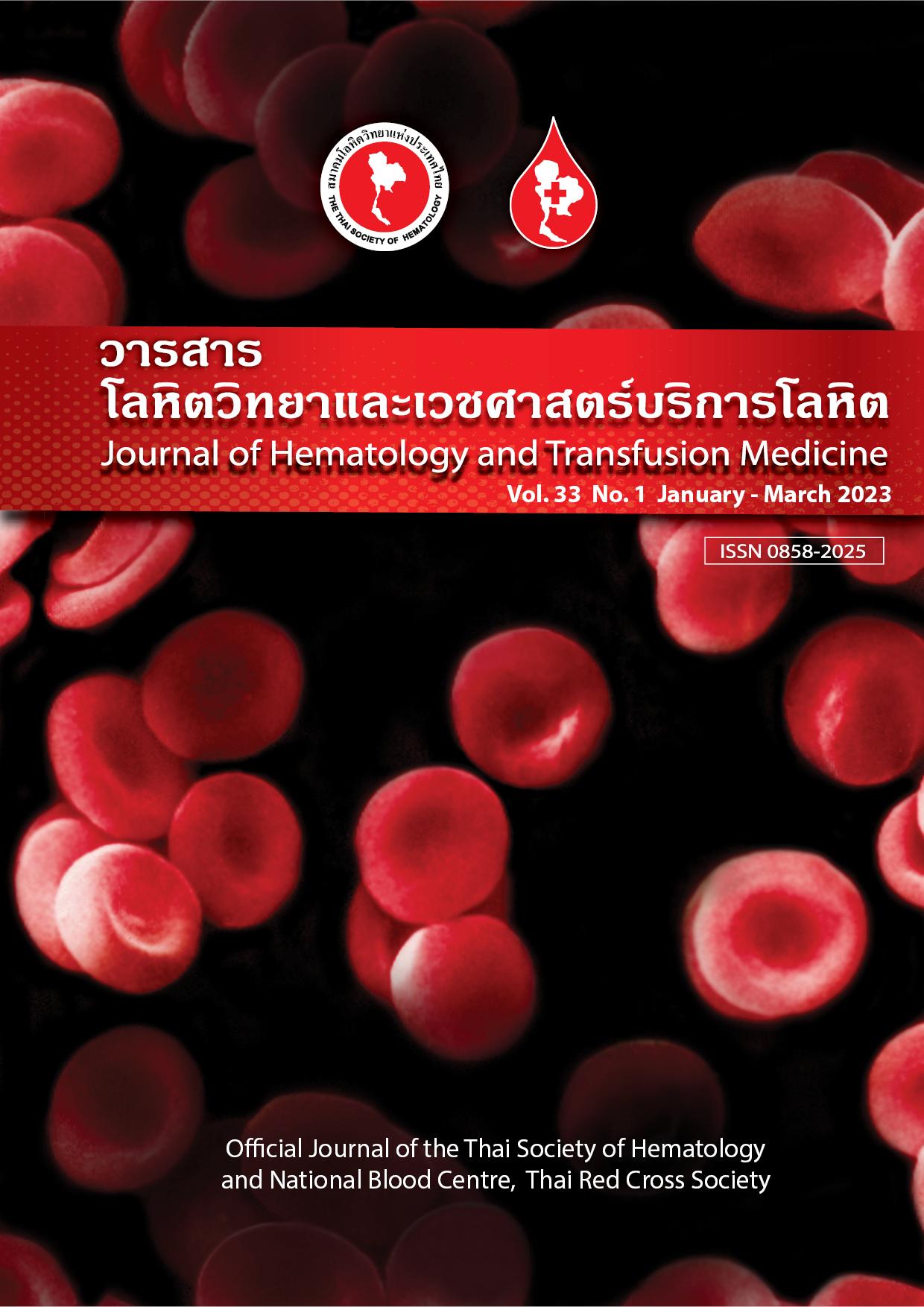Blood donation motivation of donors in Phuket province
คำสำคัญ:
• แรงจูงใจในการบริจาคโลหิต • ผู้บริจาคโลหิตบทคัดย่อ
บทคัดย่อ
บทนำ จากสถานการณ์การระบาดของโควิด-19 ในช่วงระยะเวลาเกือบ 3 ปีที่ผ่านมา ปัญหาการขาดแคลนโลหิตเกิดขึ้นอย่างหนักมากกว่าเดิมเนื่องจากมีผู้บริจาคโลหิตมีจำนวนที่ลดลง การศึกษาครั้งนี้จึงเกิดขึ้นโดยเป็นการวิจัยเชิงพรรณนาแบบภาคตัดขวาง วัตถุประสงค์ เพื่อศึกษาแรงจูงใจในการบริจาคโลหิตของผู้บริจาคโลหิตในจังหวัดภูเก็ต และเพื่อเปรียบเทียบแรงจูงใจในการบริจาคโลหิตของผู้บริจาคโลหิตในจังหวัดภูเก็ต จำแนกตามคุณลักษณะส่วนบุคคล ซึ่งประกอบด้วย เพศ อายุ ระดับการศึกษา อาชีพ และรายได้ วัสดุและวิธีการ เก็บข้อมูลโดยใช้แบบสอบถาม ระหว่างวันที่ 8-16 สิงหาคม พ.ศ. 2565 รวมทั้งหมด 274 ราย วิเคราะห์ข้อมูลและนำเสนอร้อยละ ค่าเฉลี่ย และส่วนเบี่ยงเบนมาตรฐาน สถิติการทดสอบ independent t- test และการวิเคราะห์ความแปรปรวนทางเดียว one way ANOVA และทำการเปรียบเทียบรายคู่ด้วยวิธีการทดสอบแบบ least significant difference (LSD) ผลการศึกษา พบว่า กลุ่มตัวอย่างส่วนใหญ่เป็นเพศหญิง (ร้อยละ 58.80 ) อายุระหว่าง 31-40 ปี (ร้อยละ 31.40) ระดับการศึกษาปริญญาตรีมากที่สุด (ร้อยละ 47.80) ประกอบอาชีพพนักงานบริษัทเอกชน (ร้อยละ 50.00) และมีรายได้ 10,001-20,000 บาท/เดือน (ร้อยละ 44.50) ค่าเฉลี่ยแรงจูงใจในการบริจาคโลหิต 3 อันดับแรกประกอบด้วย เอื้อเฟื้อเผื่อแผ่ต้องการช่วยเหลือผู้อื่น มีความสุขจากการได้บริจาคโลหิต และรู้สึกได้ทำบุญ ระดับแรงจูงใจในการบริจาคโลหิตอยู่ในเกณฑ์ระดับปานกลาง (X = 3.39) ผู้บริจาคโลหิตที่มีเพศ ระดับการศึกษา และรายได้ที่ต่างกันมีแรงจูงใจในการบริจาคโลหิตที่ไม่แตกต่างกัน ส่วนอายุที่ต่างกันมีแรงจูงใจในการบริจาคโลหิตแตกต่างกันอย่างมีนัยสำคัญทางสถิติที่ระดับ 0.05 และพบว่าอาชีพที่ต่างกันมีแรงจูงใจในการบริจาคโลหิตด้านผลตอบแทนหลังการบริจาคโลหิตแตกต่างกันอย่างมีนัยสำคัญทางสถิติที่ระดับ 0.05 สรุป ควรเพิ่มการประชาสัมพันธ์ให้เข้าถึงประชาชนในกลุ่มอายุที่สามารถบริจาคเลือดได้ รวมทั้งเน้นการให้ความรู้แก่เยาวชนเกี่ยวกับการบริจาคโลหิตให้เพิ่มขึ้นเพื่อให้คงแรงจูงใจในการบริจาคได้ต่อเนื่องยาวนาน
Abstract:
Introduction: From the situation of the COVID-19 epidemic three years ago, the blood shortage problem has become more severe than ever due to the decreased number of blood donors.This research was a cross-sectional descriptive study. Objective: Study the blood donation motivation of donors in Phuket province and compare blood donation motivation with personal characteristics (gender, age, education, occupation and monthly income). Materials and Methods: Data were collected from 274 blood donors using questionnaires as the collecting tools during the period 8th-16th August 2022. Statistics used for analysis were percentages, means, standard deviations, independent t-test, one way ANOVA and pairwise comparison test with least significant difference (LSD). Results: The majority of blood donors were female (58.80%), age range 31-40 years (31.40%), had completed bachelor’s degrees (47.80%), company employee (50.00%) and monthly income of 10,001-20,000 baht (44.50%). The major of motivation were altruism, feeling of happiness from blood donation and making merit. The level of motivation about blood donation was medium (X = 3.39). Blood donors with different gender, education and monthly income did not have different motivation for blood donation. Blood donation with different age had different motivation of blood donation with statistical significance (p < 0.05). Blood donation with different occupation had different motivations in terms of reward from blood donation with statistical significance (p < 0.05). Conclusion: Increase public relations to reach the age group eligible to donate blood and educating younger generations about blood donation can increase national blood donation and can be successive and long lasting for blood donation.
Downloads
เอกสารอ้างอิง
National Blood Centre, Thai Red Cross Society. Annual report 2020. Bangkok: National Blood Centre, Thai Red Cross Society; 2021.
Silpcharu S. Research and statistical analysis with SPSS and AMOS. 13rd ed. Bangkok: Saman Business R&D; 2012.
Intharasongkroh D, Tridech P, Pandii W. Blood donation decision in Bangkok Metropolitan.
J Boroma Col Nurs. 2013;29:65-81.
Sojka BN, Soija P. The blood donation experience : self-reported motives and obstacles for donation blood. Vox Sang. 2008;94:56-63.
Jamroomjan N. The economics of repeated blood donation [thesis]. Phatum Thanee:
Thammasat University; 2009.
Petsarakul S. Attitude of people towards blood donation in Amphoe Mueang Changmai [IS]. Changmai: Changmai University; 2009.
Suttisakorn U, Wattananonsakul S, Chiewsilp D. Donation behavior of blood donor at National Blood Centre, Thai Red Cross Society. J Hematol Transfus Med. 2014;24:251-60.
Suemnig A, Konerding U, Hron G, Lubenow N, Alpen U, Kohlmann T, et al. Motivational factors for blood donation in first-time donors and repeat donors: a cross – sectional study in West Pomerania. Transfus Med. 2017;27:413-20.
Oswalt RM. A review of blood donor motivation and recruitment. Transfus Med. 1977;17:123-35.
Pratumvong K, PoomriewR, Looserevanich P. Behavioral factors and decision regarding blood donation among personnel of Bangkokthonburi University [Internet]. Bangkok: Bangkokthonburi University; 2015 [cited 2022 Jun 25]. Available from: http://bkkthon.ac.th/home/user_files/department/department-24/files/3-57.pdf.
Wongkham S. Factor affecting blood donation of donors at Blood Bank Unit, Hua Hin Hospital. Academic Service J PSU. 2015;26:83-94.
Chantalak T, Suggaravetsin P. Factors associated with voluntary non-remunerated blood donation in residents of Chantabouly district, Vientiane capital city, Lao pepple’s democratic replublic. KKU J Pub Health Resea. 2013;6:34-41.
Weidmann C, Kluter H. Blood collection and donor motivation in Germany. VOXS. 2013;8:238-41.
ดาวน์โหลด
เผยแพร่แล้ว
ฉบับ
ประเภทบทความ
สัญญาอนุญาต
ลิขสิทธิ์ (c) 2023 วารสารโลหิตวิทยาและเวชศาสตร์บริการโลหิต

อนุญาตภายใต้เงื่อนไข Creative Commons Attribution-NonCommercial-NoDerivatives 4.0 International License.



